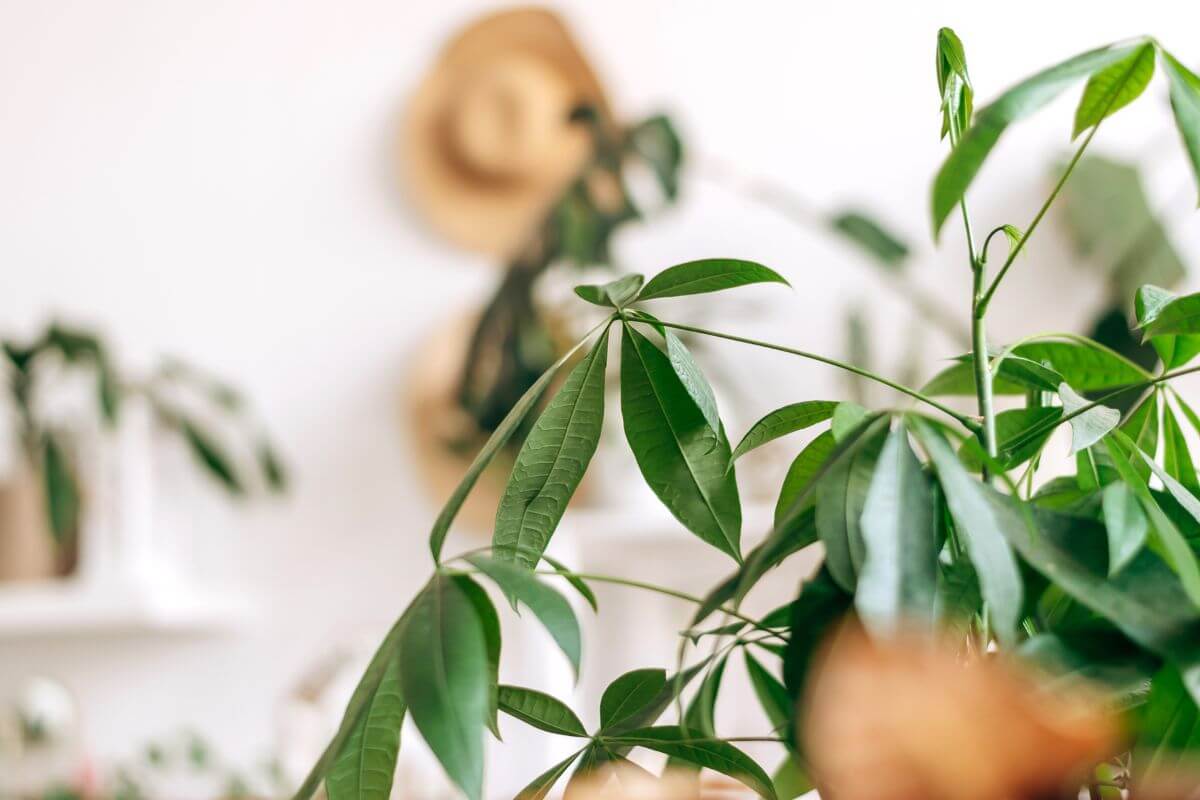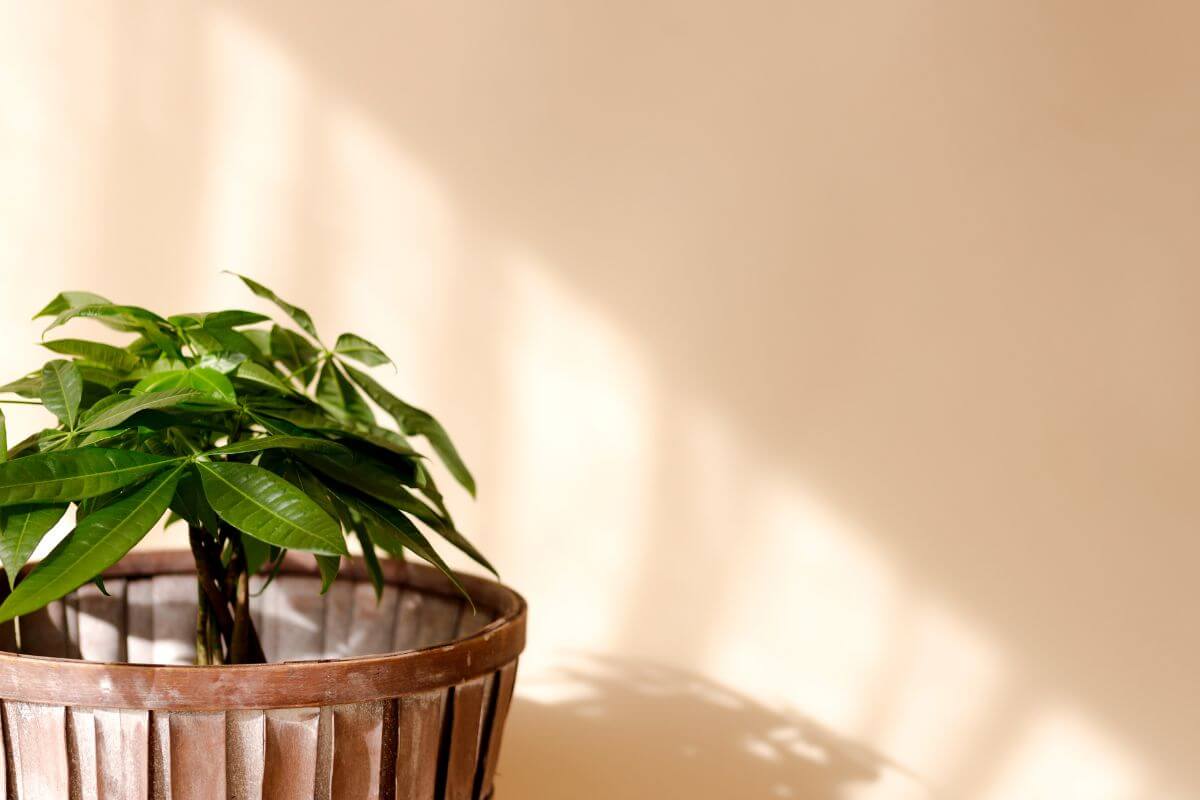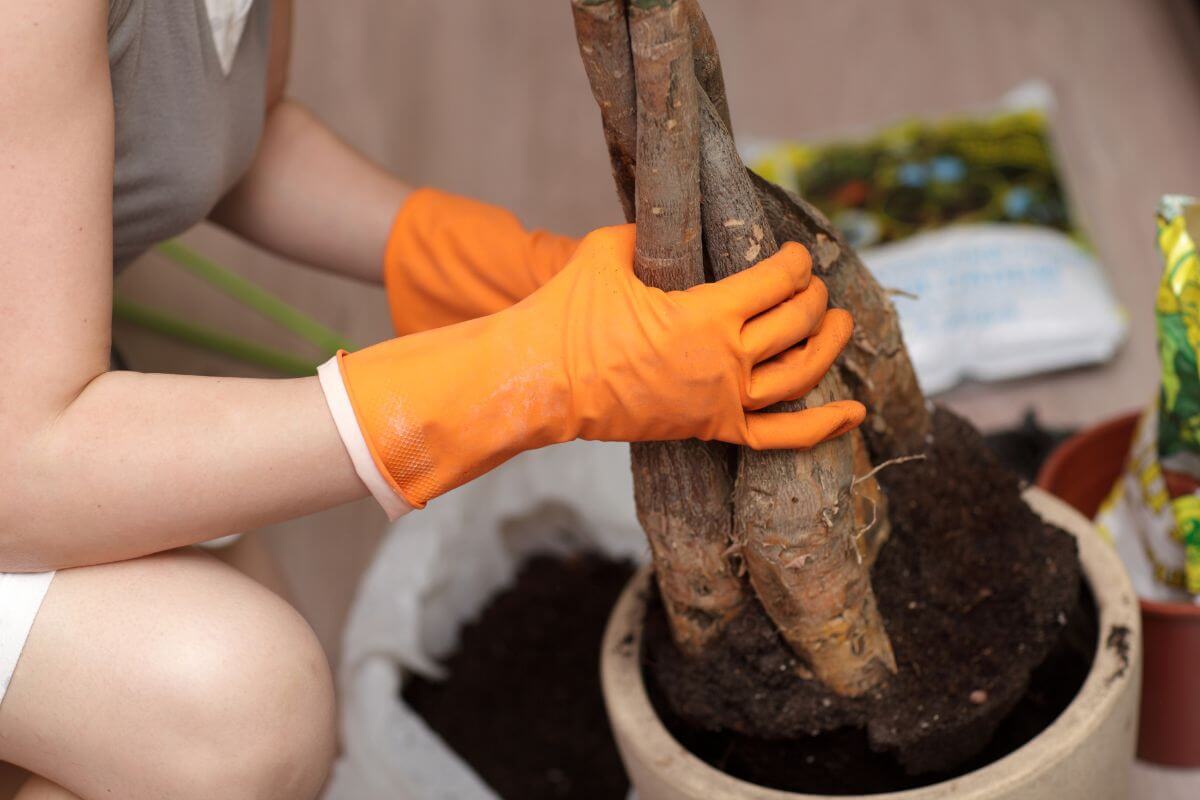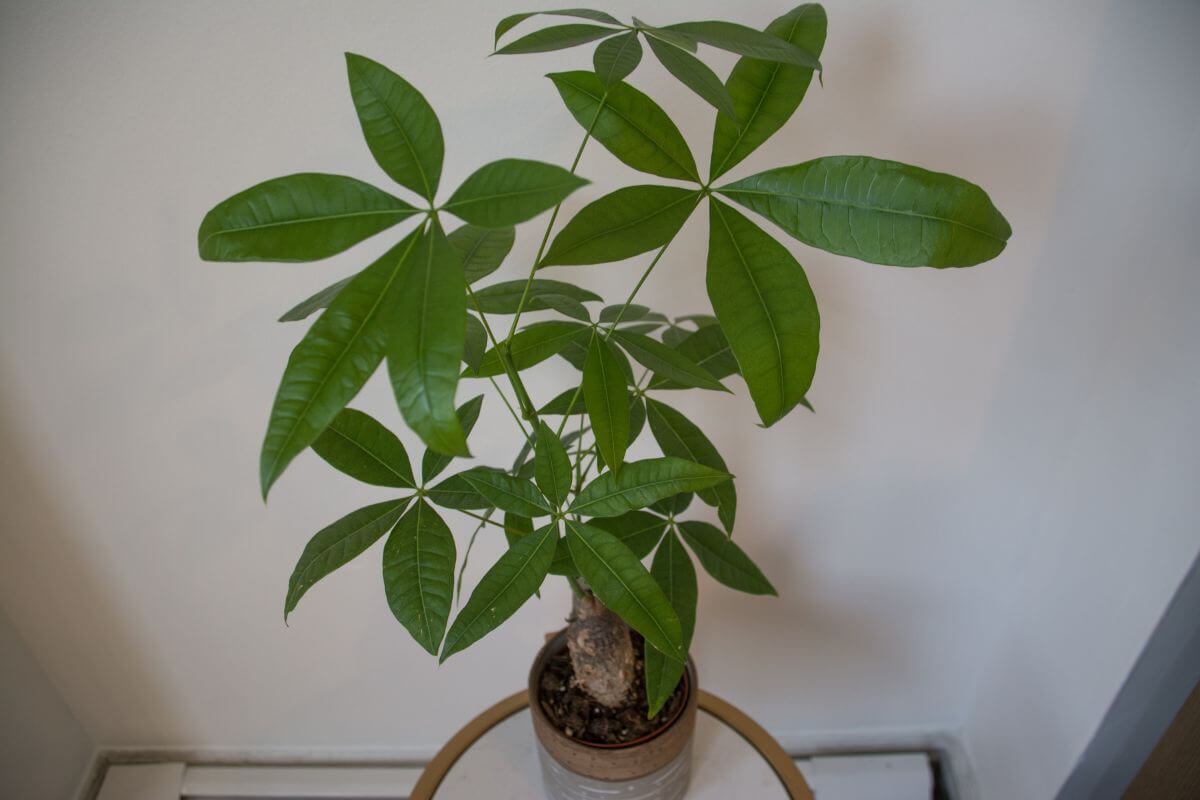Don’t we all wish money could grow on trees! But since it can’t, at least you can cultivate a Money Tree Plant to bring good luck and financial success.
In Feng Shui principles, money tree plants are believed to bring positive energy, good luck, and prosperity to its owners.
Learn more about this houseplant and how to care for money tree plants to bring luck and money to your home.
Money Tree Plant Overview

Botanically known as the Pachira Aquatica, and a member of the Malvaceae family, it is the perfect indoor guest if you want a tropical feel. Native to Mexico as well as the northern regions of Central and South America, it bears a resemblance to a palm tree.
Recognizable thanks to braided trunks and vivid green foliage, the trunk braiding isn’t natural, but a man-induced characteristic. Legend has it that good fortune is trapped in the folds.
In its native swamp habitat, this tree offers a completely different view of itself with unbraided trunks that can grow sixty feet tall. They have beautiful yellowish blooms that are followed by oversized seed pods.
Indoors, the Money Tree won’t grow much higher than six feet tall. When these plants are cultivated in nurseries, plant cultivators braid the trunks while they are still green and flexible, before they become woody and harden.
Money Tree Plant Care Guide
Environmental Conditions for the Money Tree Plant
Usually cultivated as indoor plants, they can still be grown outdoors in USDA hardy zones 10 through 12.
Indoors, they prefer a temperature range between 65° and 75° Fahrenheit. However, they will manage in temperatures as much as ten degrees either below or above, below 55°-85°
One thing that the money tree does not appreciate is a draft. These plants need to be kept away from drafty windows, halls, or doorways.
This is true for air conditioning as well as heating units and vents. Direct exposure to air currents, whether hot or cold, may result in leaf loss. A bright, somewhat steamy bathroom is an ideal location.
Soil for the Money Tree Plant
The ideal growing medium will be a peat moss-based soil mix blended with sand that is nutrient-rich. You can also add in a bit of gravel at the bottom to help with the drainage.
To prevent root rot from setting in, begin with a plant container that has a sufficient number of drainage holes to guarantee good drainage.
Light for the Money Tree Plant

The Money Tree prefers exposure to bright, indirect light. Direct sun exposure may scorch leaves.
These plants can adapt well to lower light conditions, but still prefers a good amount of indirect sunlight
To achieve well-balanced growth, consider rotating your plant on a regular basis for homogeneous light exposure, however, don’t move it from place to place, as this may disturb the plant’s well-being.
Water and Humidity for the Money Tree Plant
While this little tree enjoys humidity, be careful not to overwater. Soil beds should almost dry out between waterings.
Use the finger test by sticking your finger into the soil. When the top two to four inches of the soil bed are dry, it’s time to water the plant.
Water thoroughly until the water runs out of the drainage holes. Do not leave this plant sitting in the water.
Water every one to two weeks, depending on your climate. If you live in a warmer, dryer climate, you may need to water more often. If you live in a very high humidity climate, you can have more infrequent watering.
The money tree likes humidity. If your home or office is not particularly humid or suffers dry air, you can compensate by using a humidifier or a wet pebble tray, with the pebbles partially covered with water.
The plant should be placed on top of this tray, but be careful not to allow the plant’s container to come into contact with the water underneath.
That could lead to the soil at the bottom of the pot absorbing water through the drainage holes, which can lead to overwatering and soggy soil.
Another option is to group plants together to increase humidity by creating a microclimate for the plants. You can mist your money tree plant often.
Fertilizer for the Money Tree Plant
It is sufficient to feed your money tree plant monthly during its growing season with a standard all-purpose liquid fertilizer. Dilute the liquid plant food to half strength for best results.
In the winter months, avoid fertilizing as it’s the dormant period for the money tree.
Pruning and Potting the Money Tree Plant

More than pruning, you may want to dedicate yourself to braiding when it comes to this houseplant. While they do not require or necessitate braiding, you will find that most of those sold in flower shops, nurseries, or gardening centers are.
When you find a braided money tree, it is actually a grouping of several individual plants. Plant cultivators will braid the stems of several plants together while they are still growing, because the stems are still flexible.
If you have acquired several young plants or have grown your own from stem cuttings, you can braid your plants too.
Weave the plant stems very gently together. Tie a string or cord loosely around the plants’ tops to keep them together. As your tree grows taller, you can continue braiding.
Pruning will be necessary on occasion. Damaged, dying, or dead foliage should be trimmed off for removal.
Pruning will encourage new growth. However, it can also be used as a tool to keep the height of your plant under control.
Always use sterile scissors or garden shears to avoid transferring infections and disease to other plants. To prune, snip off just after a leaf node. You can also prune the foliage tops into a specific shape if so desired, although they are normally round.
Repotting into a larger pot will only be necessary if you want your money tree to grow larger.
Propagating the Money Tree Plant
To propagate the money tree plant :
- Take a stem cutting using clean sterile scissors or cutting shears. Your cutting should contain at least two leaf nodes.
- Dip the cut end of the stem in rooting hormone.
- Position it in a container with a basic potting mix.
- Mist the cutting and soil regularly to keep it moist.
- In approximately one month, the cutting should develop roots.
Money Tree Plant Pests, Diseases, and Problems

The money tree is susceptible to common houseplant pests including aphids and mealybugs. An organic horticultural oil, such as neem oil, applied to the plant should repel the insects before any real damage is done.
Main problems for the money tree plant come from overexposure to direct sunlight, leading to foliage scorching or excessive watering that results in root rot.
To prevent root rot, choose a pot that is not excessively large for the size of the money tree. More space means more soil, and more soil can hold more water, leading to soggy soil.
Money Tree Plant Toxicity and Pets
The American Society for the Prevention of Cruelty to Animals lists the money tree plant as non-toxic to both dogs and cats. However, ingestion may provoke an upset stomach with vomiting or diarrhea resulting.
Money Tree Plant Care Final Thoughts
All in all, the money tree plant is easy to care for and maintain. It does well indoors or outdoors, but prefers bright indirect light. Bring some good luck by planting this beautiful plant!
For more houseplants, check out these other indoor plant care guides:
Money Tree Plant FAQs
Why is a money tree called a money tree?
The money tree got its name when a man prayed for wealth and received it after planting this previously unnamed plant. He planted one tree and was able to grow many trees from the one. The multiple trees are then also braided together in a great weave into one money tree plant, giving it its name, money tree.
How big will a money tree get?
A money tree plant will grow up to 30 feet tall in its natural environment outdoors. It will grow up to 6 feet tall indoors. A money tree grows fast when planted in fertile soil, but it doesn’t grow much further after it reaches maturity.
Where should I place a money tree in my house?
According to feng shui principles, the best place for a money tree is in the southeast area of your place. That can include the southeast corner of the top of a desk or table. The money tree’s presence there is thought to bring prosperity and success to those who work near it.
How do you take care of a money tree plant?
Money tree plants are easy to grow, require little maintenance, and provide great returns. The best way to take care of a money plant is to water it regularly and prune off dead branches. Make sure to fertilize it too for faster growth. You can also braid them as they grow to weave beautiful money trees.
What is a money tree plant good for?
Money trees are plants that grow quickly and produce lots of leaves. They’re often used as decorative plants that have been known to attract positive energy into homes and offices. Some people believe that if you put a money tree inside your home, then you’ll be rich someday. Others think that having a money tree around helps keep bad spirits away. Either way, money trees make wonderful additions to any room.
Do money trees need sunlight?
Money trees do not need sunlight as they are tolerant to low light conditions. They do prefer bright light that’s indirect for optimal growth. They grow best in shady areas, where they can absorb moisture from the air. If you plant a money tree in full sun, it will dry out quickly and may wilt.


